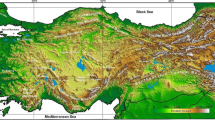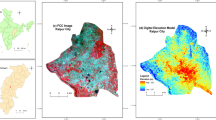Abstract
This study proposes an equivalent-elevation method to evaluate the integrated effects of latitude and elevation on regional and local-scale permafrost distribution in the Qinghai-Tibet Plateau, and to model the general permafrost-distribution patterns in regional and local-scale area. It is found that the Gaussian curve—an empirical model describing the relation between variations of altitudinal permafrost lower limit (PLL) and latitude in the Northern Hemisphere—could be applied in regional- and local-scale areas in the Qinghai-Tibet Plateau in a latitude-sensitive interval of 30°-50°N. The curve was then used to evaluate the latitudinal effect on permafrost distribution through transforming the latitudinal effect into a kind of altitudinal difference of PLL. This study then calculated the local equivalent-elevation value by overlaying the altitudinal difference of PLL onto real elevation at a certain location. The equivalent-elevation method was verified in an experimental subwatershed of the Qinghai-Tibet Plateau. However, feasibility of the method should be further tested in order to extend for future studies. The use of equivalent-elevation values can build a platform for comparing the regional general permafrost distribution in the plateau, and for basing further evaluations of local factors’ effects on regional permafrost distribution.
Similar content being viewed by others
References
Bonnaventure P P, Lewkowicz A G, 2008. Mountain permafrost probability mapping using the BTS method in two climatically dissimilar locations, Northwest Canada. Canadian Journal Earth Sciences, 45(4): 443–455.
Brenning A, Gruber S, Hoelzle M, 2005. Sampling and statistical analyses of BTS measurements. Permafrost and Periglacial Processes, 16(4): 383–393. doi: 10.1002/ppp.541
Cheng Guodong, 1983. Verical and horizontal zonation of highaltitude permafrost. Fourth International Conference on Permafrost, Washington DC: National Academy of Sciences, 136–141.
Cheng Guodong, 1984. Problems on zonation of high-altitude permafrost. Acta Geographica Sinica, 39(2): 185–193. (in Chinese)
Cheng Guodong, 1988. Review and prospect of regional geocryology in China. Journal of Geophysical Research, 10(3): 296–299. (in Chinese)
Etzelmüller B, Hoelzle M, Heggem E S F et al., 2001. Mapping and modelling the occurrence and distribution of mountain permafrost. Norwegian Journal of Geography, 55: 186–194.
Gruber S, Hoelzle M, 2001. Statistical modelling of mountain permafrost distribution: Local calibration and incorporation of remotely sensed data. Permafrost and Periglacial Processes, 12(1): 69–77. doi: 10.1002/ppp.374
Harris C, Arenson L U, Christiansen H H et al., 2009. Permafrost and climate in Europe: Monitoring and modelling thermal, geomorphological and geotechnical responses. Earth-Science Reviews, 92(3–4): 117–171. doi: 10.1016/j.earscirev.2008.12.002
Hoelzle M, 1992. Permafrost occurrence from BTS measurements and climatic parameters in the eastern Swiss Alps. Permafrost and Periglacial Processes, 3(2): 143–147. doi: 10.1002/ppp.3430030212
Hoelzle M, Haeberli W, Keller F, 1993. Application of BTS measurements for modelling mountain permafrost distribution. Sixth International Conference on Permafrost, 1: 272–277.
Hoelzle M, Mittaz C, Etzelmüller B et al., 2001. Surface energy fluxes and distribution models of permafrost in European mountain areas: An overview of current developments. Permafrost and Periglacial Processes, 12(1): 53–68. doi: 10.1002/ppp.385
Isaksen K, Hauck C, Gudevang E et al., 2002. Mountain permafrost distribution in Dovrefjell and Jotunheimen, southern Norway, based on BTS measurements and DC tomography data. Norwegian Journal of Geography, 56(2): 122–136.
Janke J R, 2005. The occurrence of alpine permafrost in the Front Range of Colorado. Geomorphology, 67(3–4): 375–389. doi: 10.1016/j.geomorph.2004.11.005
Julián A, Chueca J, 2007. Permafrost distribution from BTS measurements (Sierra de Telera, Central Pyrenees, Spain): Assessing the importance of solar radiation in a mid-elevation shaded mountainous area. Permafrost and Periglacial Processes, 18(2): 137–149. doi: 10.1002/ppp.576
Lewkowicz A G, Bonnaventure P P, 2008. Interchangeability of mountain permafrost probability models, northwest Canada. Permafrost and Periglacial Processes, 19(1): 49–62. doi: 10.1002/ppp.612
Lewkowicz A G, Ednie M, 2004. Probability mapping of mountain permafrost using the BTS method, Wolf Creek, Yukon Territory, Canada. Permafrost and Periglacial Processes, 15(1): 67–80. doi: 10.1002/ppp.480
Li Xin, Cheng Guodong, 1999. The response model of highelevation permafrost to global climate change. Science in China (Series D), 29(2): 185–192. (in Chinese)
Nan Zhuotong, Li Shuxun, Liu Yongzhi, 2002. Mean annual ground temperature distribution on the Tibetan Plateau permafrost distribution mapping and further application. Journal of Glaciology and Geocryology, 24(2): 142–148. (in Chinese)
National Research Council of Canada, 1988. Glossary of Permafrost and Related Ground-ice Terms. National Research Council of Canada, 142: 156.
Riseborough D, Shiklomanov N, Etzelmüller B et al., 2008. Recent advances in permafrost modelling. Permafrost and Periglacial Processes, 19(2): 137–156. doi: 10.1002/ppp.615
Wu Qingbai, Li Xin, Li Wenjun, 2000. Computer simulation and mapping of the regional distribution of permafrost along the Qinghai-Xizang Highway. Journal of Glaciology and Geocryology, 22(4): 323–326. (in Chinese)
Wu Qingbai, Zhang Tingjun, Liu Yongzhi, 2010. Permafrost temperatures and thickness on the Qinghai-Tibet Plateau. Global and Planetary Change, 72(1–2): 32–38. doi: 10.1016/j.gloplacha.2010.03.001
Zhou Youwu, Guo Dongxin, Qiu Guoqing et al., 2000. Geocryology in China. Beijing: Science Press, 309–310. (in Chinese)
Author information
Authors and Affiliations
Corresponding author
Additional information
Foundation item: Under the auspices of Major State Basic Research Development Program of China (No. 2010CB951402), National Natural Science Foundation of China (No. 41101067), Foundation for Excellent Youth Scholars of Cold and Arid Regions Environmental and Engineering Research Institute, Chinese Academy of Sciences (No. Y184A91001), Research Program of State Key Laboratory of Frozen Soil Engineering of Cold and Arid Regions Environmental and Engineering Research Institute, Chinese Academy of Sciences (No. SKLFSE-ZQ-10)
Rights and permissions
About this article
Cite this article
Li, J., Sheng, Y., Wu, J. et al. Modeling regional and local-scale permafrost distribution in Qinghai-Tibet Plateau using equivalent-elevation method. Chin. Geogr. Sci. 22, 278–287 (2012). https://doi.org/10.1007/s11769-012-0520-6
Received:
Accepted:
Published:
Issue Date:
DOI: https://doi.org/10.1007/s11769-012-0520-6




